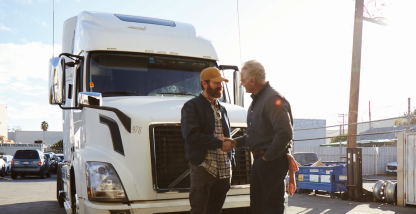Global warming, greenhouse gas emissions, and the depletion of Earth’s natural resources are a growing concern. Scientists warn of climate dangers. Governments establish fresh regulations. Meanwhile, businesses have recognized the value of considering logistics and environment together. Green logistics can help a company reduce climate impact. Embracing sustainable logistics also helps delivery and trucking companies.
What is green logistics?
Green logistics, also called eco-logistics, looks at making operations more sustainable. Every area of the business can be evaluated and optimized, including making changes to:
- Reduce greenhouse gas emissions.
- Cut energy use.
- Lower fuel consumption.
- Streamline delivery routes.
- Use the most efficient equipment.
- Adjust product sourcing.
- Improve warehouse efficiency.
- Source ethically.
- Offset carbon emissions.
- Rely on clean fuel, renewable energy sources.
- Measure and report sustainability metrics.
Why does sustainable logistics matter?
Transportation is a sector of the economy with the greatest greenhouse gas emissions, according to the Environmental Protection Agency (EPA). Transportation includes the movement of people and goods by cars, trucks, trains, ships, airplanes, and other vehicles. In 2019 this sector contributed 6,558 million metric tons of CO2 equivalent, making it responsible for 29% of the country’s greenhouse gases.
Supply chain logistics has a quantifiable impact on the environment. It can also impact a business’s bottom line. Customers are growing more environmentally conscious, which means sustainability practices are even more vital to purchasing decisions.
A green supply chain sees shippers decreasing their carbon dioxide emissions, dealing with waste disposal and overall waste management, using recyclable materials, and more. Sustainable logistics can help companies stand out and thrive as they make ambitious zero-net goals or promise to go as green as possible.
How to measure your carbon footprint
- There are many calculators available online to help businesses measure their carbon footprint. When measuring your carbon footprint, Puro Earth explains you’ll need to decide “which parts of the value chain you want to include” and “at which accuracy level the calculation will be made.” You should also understand “why the carbon footprint calculation is needed, as this affects the level of accuracy required.”
How does logistics affect the environment?
Yes, electric vehicles are on the logistics horizon. However, gas-powered vehicles are the standard for delivery and hauling. These vehicles emit significant CO2 into the atmosphere. With online shopping and the need for last-mile delivery increasing, logistics industry emissions are predicted to grow.
Green logistics emphasizes optimized supply chain management to decrease the time and mileage spent performing the same amount of deliveries. Reducing energy consumption and asset wear with more efficient logistics processes not only increases profitability but also reduces the environmental impact.
Can you save money through sustainable logistics?
A sustainable logistics environment benefits the planet and your business. Green logistics is about increasing efficiency and optimizing asset use, benefiting your bottom line too.
Green logistics helps you save money by:
- Reducing fuel costs
- Optimizing routes
- Improving dispatch and workflow
- Keeping up with preventative maintenance
- Avoiding vehicle breakdowns
- Prolonging asset life
You’ll be more profitable too. For example, route optimization can help you plan your deliveries smarter and save time. That makes your customers happy and brings in more business. Plus, your drivers will be happier with how you run your operations, which can make it easier for you to retain your top talent.
Keep in mind that consumers are putting increasing pressure on companies to prioritize sustainability. This means your customers are looking to improve the sustainability of their supply chains. You may better retain your current client base and appeal to new customers with green logistics strategies.
Top tips for employing sustainable logistics
You can’t just flip a switch and go green. Sustainable logistics requires new approaches to many of the old ways of doing things. Try these top tips to give green logistics greater priority in your operations.
Optimize route planning
Drivers, operations managers, and customers all benefit from route optimization. Identifying the best way to get to a destination involves finding the most time- and cost-efficient routes. The planning also considers how to maximize the time and number of orders without compromising compliance-required stops.
Robust route optimization software can help by performing complex calculations weighing:
- Customer time windows
- Vehicle capacity
- Traffic congestion
- Distance between stops
Find fuel savings
Motive’s Fuel Hub uses telematics to analyze driver and vehicle fuel efficiency. With the power of artificial intelligence analyzing the billions of daily data points on our network, Fuel Hub can identify how, and where, your fleet can save on fuel with unparalleled accuracy.
With AI helping you to understand trends and benchmark performance, you can compare your fleet against others with the same vehicle types. Review an individual driver’s fuel consumption over time to identify behaviors that could impact fuel economy. Motive’s driver coaching tools even help you address wasteful habits such as hard braking or speeding.
Reduce idling
Truck idling is costly. Excessive vehicle idling hurts the vehicle’s engine life and inflates fuel costs. A typical truck consumes 1,800 gallons per year in idling. The cost is about $4,300 per year in idle fuel consumption. Plus, idling causes an estimated $2,000 annual increase in maintenance costs per truck.
Although there are valid reasons to address idling, it’s also harmful to the environment. The Environmental Protection Agency (EPA) reports that truck and locomotive engine idling emits 11 million tons of carbon dioxide annually, along with 200,000 tons of oxides of nitrogen and 5,000 tons of particulate matter. Idling pollutants have also been linked to serious human illnesses including asthma, heart disease, chronic bronchitis, and cancer.
Protect asset lifespan
Sustainability doesn’t stop at cutting carbon emissions. Environment logistics also considers the importance of fully using our resources. Every truck has a finite lifespan. Maintenance, refurbishment, and replacements aren’t always environmentally friendly.
Reducing wear and tear and working to extend the lifetime of your assets increases return on investment. At the same time, you reduce waste and prioritize end-to-end sustainability.
Digitize paper
Technological advancements have rendered paper trails obsolete. With an electronic logging device, everything you need to know about a trip (e.g., miles, fuel, IFTA reporting) is recorded digitally.
Digital driver dispatch software also does away with dispatch paperwork by automatically delivering the relevant information to the driver’s phone.
Giving drivers the ability to track vehicle inspections and maintenance information in an app also eases the burden of reporting. The necessary records are impossible to lose as they’re immediately accessible to fleet managers. Plus, the electronic logs are more accurate than those kept manually, on paper, by busy drivers.
How to use Motive as your green logistics program
Motive’s fleet management software supports green logistics. Limit fuel consumption and costs with GPS tracking and route optimization. Putting drivers on the most efficient routes also reduces wear and tear on valuable fleet assets. Cut back on idling time too.
With the ability to monitor asset diagnostics in a single dashboard, you can find fuel savings and also schedule preventative maintenance to prolong asset lifespans. The digital solutions from Motive also streamline logging and compliance with ELD devices and an easy-to-use Driver App.
Successful green logistics requires total visibility into every aspect of fleet management. Over 120,000 businesses trust Motive to improve the sustainability, safety, and profitability of their fleets. Request a demo today.










